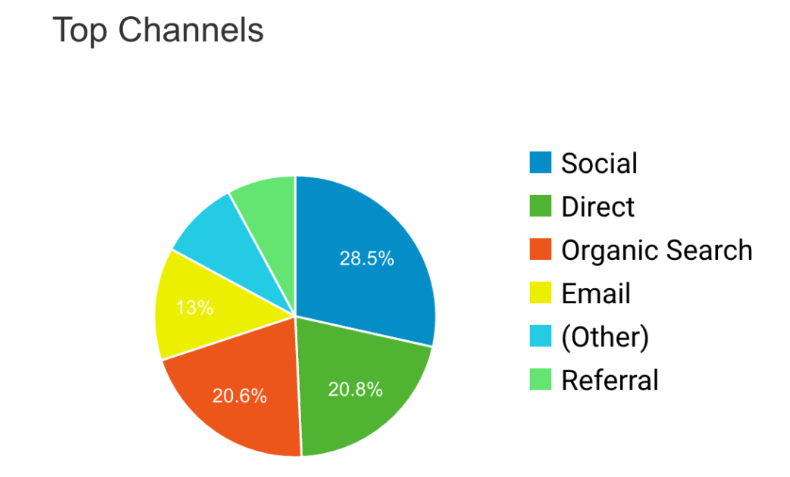
The Quickstart Guide to Data-Driven Marketing
The more you know about your customers and their preferences, the better equipped you are to serve them.
Let’s say you and your family are out for a Sunday drive in the country. Would you rather be able to clearly see the road in front of your car, or would you prefer to drive blindfolded?
Crazy question… right?
When you ignore the data and base your marketing strategy on gut feelings or management team consensus, you’re pretty well doing the same thing. You’re driving blind, and chances are high you’re going to crash at some point.
Today’s digitally-based business environment thrives on accurate information. The more you know about your customers and their preferences, the better equipped you are to serve them.
And the competition is fierce.
If you’re not making data-driven decisions, but your competitors are, they’re doing pushups while you’re playing hopscotch. Before long, you’ll get trounced.
Strong words?
You bet. My aim here is to help you gear up to lead the pack instead of eating dust.
Here’s a down and dirty quickstart guide to data-driven marketing.
The quickstart guide to data-driven marketing. Click To TweetData-driven marketing – a working definition
First off, please know I’m not totally dismissing gut instinct or seasoned experience as irrelevant to decision making. There are times when going with what you already know pays off big.
In the world of digital marketing, though, you have too many ways to fact-check your gut to rely on intuition alone. Your experience and feel for the business are invaluable. But prove them out by collecting and analyzing hard, cold facts.
My definition of data-driven marketing is this: using qualitative (ex: user testing) and quantitative (ex: analytics) observations derived from customer-focused data points to better understand the marketplace, its preferences, and its actions.
If you have observed that Mary responds well to discount codes sent to her via email, while Bill doesn’t open emails, but loves to browse your ecommerce site for boating equipment, you’re better prepared to tailor the marketing messages you present to them.
The power of data-driven marketing is its incredible ability to personalize your campaigns and speak to people as individuals. It’s the shortcut to customer satisfaction and increased sales.
Data-driven marketing – who needs it?
If you have an online ecommerce or lead-generation presence, you can benefit from collecting and interpreting data – as long as you then feed those results back into your strategy.
Too often, at The Good, we see clients who are experts at collecting data, but neophytes or worse at utilizing it. Results require action. It’s better to focus on a small amount of data that you put into use than to collect a ton of data and not do anything with it.
Given the sheer volume of information available, and the plethora of tools available to collect it, most CMO’s and ecommerce managers suffer from data overload. Too much information can quickly swamp the boat, leaving dazed and confused executives trying to make sense out of the mess.
Here are some of the symptoms we see:
- Execs getting angry when data points contradict their plans
- Execs refusing to even look at the data, claiming it can’t be trusted
- Budgets that don’t provide adequately for optimization funding
- Arguments that begin with “We’ve always done it like this…”
- Arguments that begin with “I don’t care what the data says…”
Have you ever seen or heard behaviors like that? Have you felt the symptoms of data overload yourself?
Don’t despair. I can show you how to fix that problem.
How to cure data overload
Remember, our definition says data-driven marketing uses “quantifiable observations.” Since quantities can be counted, there’s light at the end of the data-filled tunnel. Simple arithmetic and a few well-chosen formulas are all you need to get started.
Once you’ve covered the bases, you can take data interpretation and activation as far as you want to go. You can get complex. You can predict customer behavior, or you can present personalized offers to visitors based on their prior choices.
But you shouldn’t do any of that until you have the basic formulas in use. And by “in use,” I don’t mean just spewing out numbers, I mean you’re using those numbers to create tactics that feed back into your system to make themselves better.
Yes, data-driven marketing is all about continuous growth. Just like interest in a savings account.
Here’s how to cure data overload. Click To TweetWhich data should you begin with?
Once your data collection and utilization strategy is well-oiled, you’ll begin fitting data points to your goals. Every goal should be measurable. Proper data collection allows you to evaluate progress and helps you make adjustments to the things that matter most in your business.
There are some things, though, that pretty well every company is well-advised to track, analyze, and make good use of.
Here’s your data-driven marketing quickstart list of essential checkpoints:
Site performance
Page load time is critical. Use Pingdom or another tool to make sure your site isn’t lagging. About 25 percent of your visitors will abandon your site if it takes any longer than four seconds to load. Note the load time stats for Amazon.com (see the graphic below). The load time is a blazing 1.46 seconds. Amazon knows the importance of getting seen NOW.

Lead-generation channels
Where are most of your leads coming from? Is social media paying off for you? How effective is your email marketing? Are organic search results sending traffic to your site? What are the percentages of delivery from each of your incoming channels? Your analytics platform will tell you… but are you listening?
Conversion rate
How effective is your ecommerce or lead-generation website? What percentage of your visitors go on to make a purchase or register for more information? The average conversion rate runs about three percent. What’s yours? How has it varied over the past six months? To fine-tune this metric, you can begin looking at micro-conversions – decisions prospects make on their way to becoming buyers. That will allow you to determine crucial stuck points that can make or break your sales efforts.

Cart abandonment rate
How many of your visitors load something in a shopping cart, but then abandon that cart before checking out? Once you know how severe the problem is (for most ecommerce websites, close to 70 percent of shoppers don’t follow on through to the purchase), you can ratchet down to determine WHY they’re not making the purchase and WHAT you can do about it.
Products per transaction
Here’s another area where conversion optimization work can pay off handily. They’re already buying something. What would happen to your sales if each customer purchased an additional item on every order? Would that be exciting news to report at the next management or board meeting?
That gives you five critical metrics to track, learn from, and use to inform your marketing and sales strategy. It also gives you a way to get out from under information overload. You can set up and track the quickstart checkpoints with basic tools. A degree in analytics is not required to get on board.
Now Build a Habit
Start with these. Get to know them intimately. Check them daily. Note when they rise and fall, then seek to find out why. After a week or two of getting comfortable with quickstart data, you’ll be ready for more.
Decide what you most need to know. Determine where there are clogs in your sales pipeline. Develop theories about why those clogs exist, then run tests aimed at clearing them. Set up the data checkpoints necessary to record what’s happening.
Test and test again.
Data-driven marketing is doable by every company and every digital marketing manager, but it’s easier when you lean into it slowly, pay attention, and approach the topic with the attitude of a learning.
I know of nothing more important to your company’s financial health than data-driven conversion optimization.
At The Good, we get to witness incredible results and elated executives on a daily basis – all of it from starting with the basics of data-driven marketing optimization, and expanding as need and capability permit.
Enjoying this article?
Subscribe to our newsletter, Good Question, to get insights like this sent straight to your inbox every week.

About the Author
David Hoos
David Hoos is the former Director of Marketing at The Good, conversion rate experts who deliver more revenues, customers, and leads. David and the team at The Good have made a practice of advising brands on how to see online revenue double through their conversion rate optimization services.